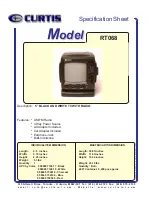
Rev 1.0 | SC5507A & SC5508A
Hardware Manual
SignalCore, Inc.
34
SC5507A & SC5508A Hardware Manual
The bulk transfer from the host to the device operates on a loopback with a data buffer of 8 bytes. When
a device register is addressed, and upon completion of the register task, such as changing frequency, it
will send back 8 bytes, which the host must read to clear the transfer buffers. Unlike the other interface
methods, where only the required number of bytes needs to be sent for a given register, 8 bytes are
needed for every USB bulk transfer. For example, if a configuration register requires only 4 bytes to be
sent, these bytes will be the first of the 8 bytes and the last 4 bytes are zeros. The returned 8 bytes do not
carry valid data for a configuration register. However, they do carry valid data for query registers.
SPI Interface
The SPI interface on the device is implemented using an 8-bit (single Byte) buffer for both the input and
output, hence, it needs to be read and cleared by the device before consecutive bytes can be transferred
to and from it. The process of clearing the SPI buffer and decisively moving it into the appropriate register
takes CPU time, so a time delay is required between consecutive bytes written to or read from the device
by the host. The chip-select pin (
𝐶𝑆
̅̅̅
)
must be asserted low before data is clocked in or out of the product.
Furthermore, pin
𝐶𝑆
̅̅̅̅
must be asserted low for the entire duration of a register transfer.
Once a full transfer has been received, the device will proceed to process the command and de-assert low
the SRDY pin. The status of this pin may be monitored by the host because when it is de-asserted low, the
device will ignore any incoming data. The device SPI is ready when the previous command is fully
processed and the SRDY pin is re-asserted high. It is important that the host either monitors the SRDY pin
or waits for 500
𝜇𝑠
between register writes.
There are 2 SPI modes: 0 and 1. The default mode is 1, where data is clocked in and out of the device on
the falling edge of the clock signal. In mode 0, data is clocked in and out on the rising edge. To select
mode 0, pin 23 of the interface connector must be pulled low to ground as the device is powered on or as
the reset line (pin 19) is toggled low-high. If pin 23 is pulled high or left unconnected, mode 1 is selected.
Figure 4. SPI Mode 1 shown.
Register writes are accomplished in a single write operation. Register lengths vary depending on the
register. They vary in lengths of 2 to 8 bytes, with the first byte sent being the register address followed
by the data associated with that register. The (
𝐶𝑆
̅̅̅
) pin must be asserted low for a minimum period of 1
𝜇𝑠
(T
s
, see Figure #) before data is clocked in, and must remain low for the entire register write. The clock
rate may be as high as 5.0 MHz (T
c
= 0.2
𝜇𝑠
), however, if the external SPI signals do not have sufficient
integrity due to trace issues, the rate should be lowered.
MSB
CS
MISO
MOSI
CLK
MSB
LSB
LSB






































